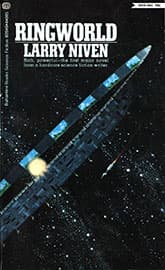Ringworld
Critique • Quotes
 First edition (paperback), 1953
First edition (paperback), 1953First book publication
1970
Literature form
Novel
Genre
Science fiction
Writing language
English
Author's country
United States
Length
Approx. 103,000 words
Running rings around critics
Larry Niven's popular novel has dated in the five-plus decades it's been around—though you can still find plenty of hard science fiction fans who consider it a modern classic.
Ringworld arose from a certain tradition in the science fiction genre. Well, hard science fiction obviously. In 1970 the novel appeared just as the swamping of the field by the so-called New Wave—based on social, philosophical and psychological insights more than on scientific and technological ideas—was starting to seem complete. The success of Niven's throwback novel gave hardcore readers hope that the soft science fiction wave could be repulsed. As it turned out, both the new and old schools would continue to be represented in the market for years to come.
But also within hard science fiction there's a common story that Ringworld exemplifies, a theme sometimes jokingly referred to as the Big Dumb Object (BDO).
In this kind of story, spacefarers discover a mysterious alien artefact—usually large and ominously silent. They explore it and seek the aliens that must have created it. Inevitably our explorers are threatened, attacked or captured by the advanced technology. Think of Arthur C. Clarke's monolith in "The Sentinel" (1951) and 2001: A Space Odyssey (1968), or his cylindrical world in Rendezvous with Rama (1973). Or the starship base in a hollowed out asteroid in Frederick Pohl's Gateway (1977). Or Dyson spheres in various science fiction and nonfiction works. Or dozens of mysterious deep-space objects (including a memorable Dyson sphere) in Star Trek episodes over the years.
In Ringworld, the BDO is a ring constructed around a sun. Our investigators are a motley team of a male and a female earthling alongside two very different extraterrestrials (species drawn from Niven's other works that take place in what he calls Known Space). Much of the drama focuses on the interpersonal relations of these four, but really in this hard science fiction work, the technology is what the book's about. If you're not intrigued by how and why the ringworld was created or by what went wrong with it, why it seems to have been abandoned by its creators, how our heroes can escape it, there's not much for you here.
Even if you're into the adventure-with-a-mysterious-big-thing, Niven's writing may leave you confused. His descriptions of what the explorers come upon are vague. It can be hard for readers to visualize what exactly is happening at any given moment.
Sex object in space
The same goes for the character interactions. Like the figures in the novels of other hard science writers, such as Clarke and Isaac Asimov, they are each one-dimensional. But at least in those other authors' hands their interactions are clearly drawn. Niven has a habit of having people spout long strings of excited dialogue at each other, only afterwards explaining what they were going on about. The motivations for their exchanges are often left unclear.
The earthling female on the team, Teela, seems to be in this novel for one purpose only: to serve as a sex object—to begin with, for the earthling male, Louis. The brazen sexism of Ringworld jumps out at a reader today. But even in 1970 it must have seemed chauvinistic in the extreme. It's surprising that in the period since then the novel has not come under greater attack for misogyny.
There's also some rubbish about Teela being on the exploratory team because she has been genetically selected to bring luck to the enterprise. The ludicrous notion of luck being an inherited characteristic is put forth with a straight face, which you would think would turn off the book's science-grounded readership.
Oddly, Ringworld also sparked some criticism from those fans for making what appeared to be a few errors in its science. Niven good-naturedly admitted to his mistakes and a decade later he wrote The Ringworld Engineers—first of three sequels—to address the most egregious problems.
Regardless, the novel and the subsequent series have been tremendously popular. Ringworld started by sweeping the major science fiction awards and the series went on to sell millions of copies. They've even been turned into video games. Adaptations for movies and television series have been repeatedly announced and may still be forthcoming.
Niven must have done something right in his creation of the Ringworld saga, but I'm not sure exactly what.
— Eric
Critique • Quotes

